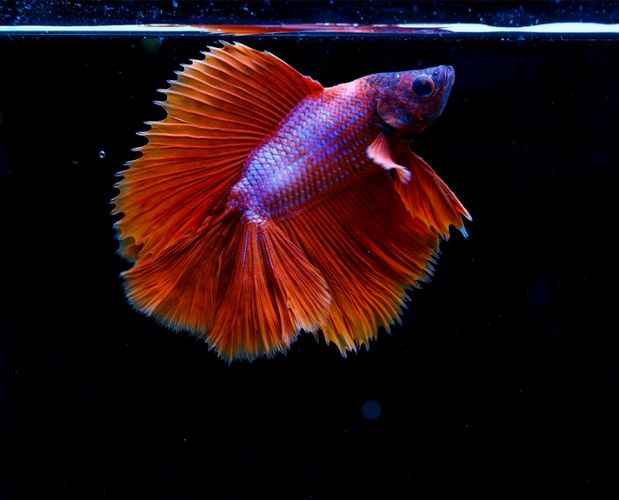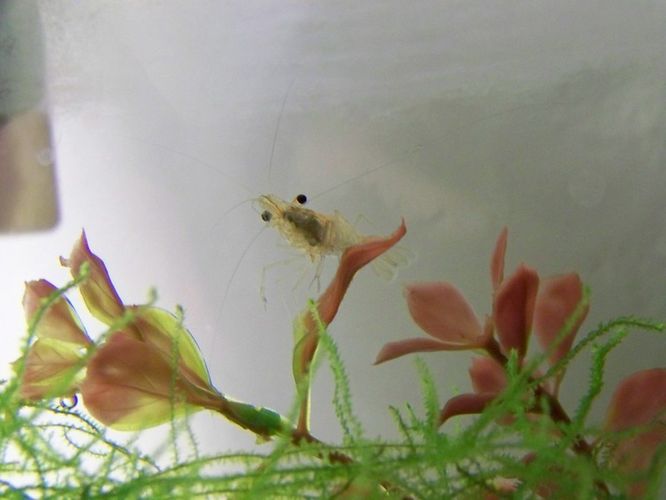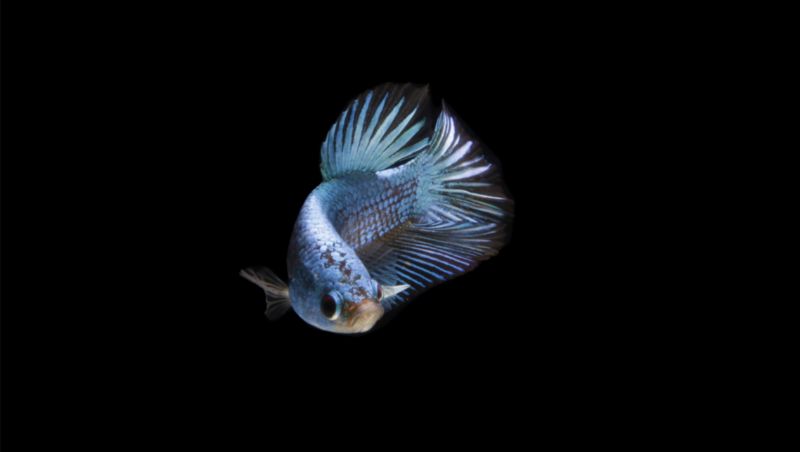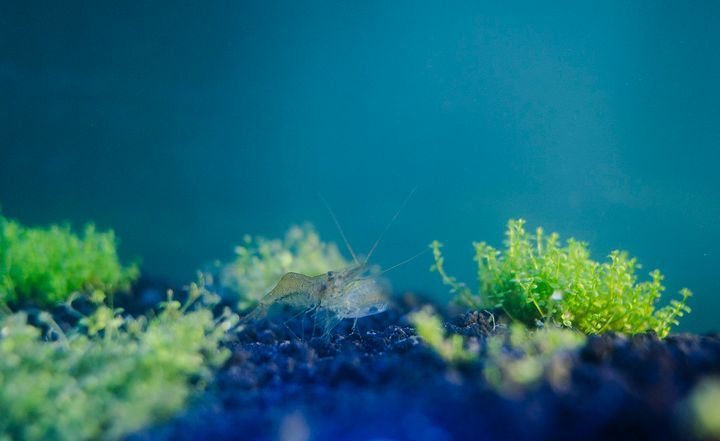You’ve likely heard that it’s difficult to find tank mates for bettas because they can be aggressive. Maybe you’ve thought about adding ghost shrimp as an alternative to fish. After all, they’re fun to watch, they clean up algae, and they’re very cheap.
But is it safe to keep a ghost shrimp and betta fish together? Is it true that bettas are hard to keep with tank mates? Is there a shrimp that might be better than the ghost shrimp?
We’ll explore all this here, so if you’re looking for a solution to your empty aquarium tank, keep reading.

Keeping Ghost Shrimp And Betta Together
Whether your betta can successfully live with ghost shrimp depends on your betta.
Many people believe that you can never house a betta with other creatures. We call bettas, “Siamese Fighting Fish” because they’re known for their aggression.
Still, bettas can often live with other creatures. It depends on the creature and the temperament of your betta.
Male bettas should NEVER live with another male or female betta. You can sometimes keep females together in sororities. But, sororities are difficult to keep successfully. You really need to do your research before jumping in.
The bottom line is, DON’T house your betta with another betta. But you likely CAN house your betta with another fish or invertebrate.
So, what does that mean for keeping ghost shrimp with betta? How do you know if it’s safe to add ghost shrimp to your betta tank?
Will Your Betta Eat Ghost Shrimp?

It’s unlikely that your betta will eat the ghost shrimp — they’re too large. Still, it’s possible for larger bettas to eat ghost shrimp. They may kill the shrimp first and take bites out of it.
Some bettas are very territorial and don’t like anything else being in their aquarium tank. Ghost shrimp are small and slow-moving, so they make easy targets for an aggressive betta.
What if your betta doesn’t like the ghost shrimp being in its aquarium tank? It will only be a matter of time before it kills the ghost shrimp.
Watch your betta when adding your ghost shrimp to see how it reacts. You may need to act quickly to add the ghost shrimp to a different tank.
But, the ghost shrimp may be fine. Some betta fish do not care about them at all and will not pay them any mind. It all depends on the betta.
Signs That Your Betta Will Kill Your Ghost Shrimp?
It’s easy to tell if your betta is going to attack your ghost shrimp. There are some very obvious signs that you can watch out for.
Flaring
Bettas will flare their gill flaps when they are feeling aggressive and territorial. This is a way to warn off other bettas or threats. Flaring is a clear sign that your betta is about to attack.
Spreading Their Fins
Similarly, betta fish will spread their fins out wide to make themselves look bigger.
Head Butting & Nipping
Flaring at a ghost shrimp is usually followed by a quick jolt forward and a bite. Ghost shrimp are small and fragile and can’t handle these attacks well.
If you notice your betta behaving this way, you should remove the shrimp from the tank.
Will Ghost Shrimp Harm Your Betta?
Absolutely not. Ghost shrimp are very small, slow-moving, and peaceful. There is never a time when a ghost shrimp will attempt to attack a betta.
The only time that a ghost shrimp may harm your betta is if the ghost shrimp has an infection.
It’s always a good idea to quarantine new animals for a couple of weeks before adding them to the main tank. This allows you to observe the new animal to see if it has any parasites or sicknesses.
How To Safely House Ghost Shrimp With Your Betta

It’s possible to house ghost shrimp with your betta as long as your betta has a calmer temperament. But, if the ghost shrimp are out in the open, it’s going to be tempting for even the calmest betta. So, there are a few things you can do to protect your shrimp.
Choose A Larger Fish Tank
The first step is to choose a larger tank. This will give your betta more space so that it won’t feel as territorial. It will also give your shrimp more space to spread out and hide.
Bettas should live in at least a 5-gallon tank to begin with. You can likely get away with adding a shrimp or two to a 5-gallon tank as long as you provide lots of hiding spots.
For a better success rate, consider upgrading your betta to a 10 or 20-gallon tank. If you get one of these larger tanks, you can even consider adding small fish like tetras or danios!
Provide Lots Of Hiding Places
The most essential thing you can do to ensure your shrimp’s survival is provide hiding places. Ghost shrimp are transparent, making them difficult to see. Still, bettas will find them and kill them if they don’t have a place to hide.
Plants
Some of the best hiding places for ghost shrimp are plants. You should choose plants that have lots of leaves for the ghost shrimp to hide in. One great option is Anubius.
Plants that float at the surface are another great option. Some examples are water lettuce or red root floaters. Floating plants have thick roots that hang from the surface. These are great hiding places for ghost shrimp.
When choosing plants, we recommend choosing live plants over fake ones. This benefits your ghost shrimp as well as your betta.
Live plants not only provide a place to hide, but they provide food as well. Ghost shrimp love to feast on plant matter and the algae that grow on plants.
Live plants are better for your betta because they’re soft and easy on their fins. Bettas have long-flowing delicate fins that are easily damaged by sharp objects. This means that you shouldn’t choose plastic plants because they can rip your betta’s fins.
If you don’t want to keep live plants, you should choose silk plants. Silk plants are fake, but unlike plastic plants, they will not harm your betta.
Rocks & Decor
To keep your ghost shrimp safe, you should provide rocks or decorations. Make sure these decorations have hiding spots that your betta can’t reach. When choosing a decoration, pick one without sharp edges as this will protect your betta’s fins.
Introduce Your Ghost Shrimp First
There are two different options for adding your ghost shrimp. You can add them to the tank before the betta, or you can add them after the betta.
Usually, it’s going to be safer to introduce your ghost shrimp to the tank before the betta. This gives your shrimp plenty of time to explore the tank and find good hiding spots before the threat of a hunt.
You can do this method even if you already own a betta. Simply put some of the tank water into a cup and net your betta into the cup.
Then, redecorate the tank. It will appear as a new environment to your betta, so they should be less territorial. You can then add the shrimp and allow them to explore for about half an hour before adding your betta back in.
Yet, if you don’t already own your betta, then you don’t know what temperament your new betta will have. If you buy a betta and it becomes aggressive toward your shrimp, they’re not likely to survive.
Introduce Your Betta First
If you choose a betta first, then you can observe the betta and its temperaments. This will tell you if it’s safe to even try housing ghost shrimp with your betta in the first place.
If the betta you choose is aggressive, then no amount of hiding spots will save your ghost shrimp. The betta will hunt down the shrimp and kill it.
If you bring home a betta and it appears aggressive, it’s probably a good idea to forgo the ghost shrimp.
How Many Ghost Shrimp Can You House With A Betta?
How many ghost shrimp you keep with your betta depends on the tank size and the number of decorations.
Although ghost shrimp are small, they still produce a bioload and will dirty up the tank.
It’s better to have several ghost shrimp in a tank. They are safer in groups, and they will be able to reproduce easier. Also, if your betta does happen to kill a ghost shrimp, there will still be several left over.
Still, to keep several shrimp, you need to have the right setup. Because ghost shrimp are small, you can usually keep one shrimp for every 1 gallon of water.
Tank Requirements For Bettas & Ghost Shrimp

Both bettas and ghost shrimp have very similar housing requirements. So, keeping the tank suitable for both animals is not a problem.
For both ghost shrimp and bettas, the water parameters should look like this:
- Ammonia: 0ppm
- Nitrites: 0ppm
- Nitrates: <40 ppm
It’s very important to keep the ammonia and nitrites at “0ppm” in any tank you keep. These elements are toxic and can kill your animals. This is especially important if you’re housing ghost shrimp as they’re very fragile.
Water Temperature
Ghost shrimp thrive in temperatures between 72-82° F (22.2-27.8° C).
Bettas thrive in temperatures between 75°-80°F (24°-26.5°C).
To keep these animals together, strive to keep your tank between 75°-80°F (24°-26.5°C).
pH
Ghost shrimp do best in waters with a pH of about 7.0.
Bettas do best in waters with a pH of about 6.5-7.5.
To keep these animals together, strive to keep the pH as close to 7.0 as possible.
Water Flow & Their Natural Habitat
Ghost shrimp are native to the southeastern part of the United States. They live in both freshwater and brackish water. They love areas that are thickly planted. Because they are so small, they live in areas with very little water flow.
Bettas are native to tropical Asian river basins. They live in Vietnam, Malaysia, Thailand, and Cambodia. They live in rice paddies, river basins, small streams, and even drainage ditches. Due to this, they are also used to very low water flow.
Bettas don’t do well in a tank with a lot of water flow due to their long fins. Their long, flowy fins make it very difficult for bettas to swim against a current.
Filters
Because both animals like low water flow, you should choose a filter that doesn’t give off much of an output. The best option for both these animals is a sponge filter. They are very low flow, easy to clean, and safe for your animals.
Traditional filters can pose a threat to your betta. Their fins may get sucked into the filter intake and damaged. Traditional filters are also dangerous for ghost shrimp because they’re so small. They can also get sucked into the filter.
Food
Ghost shrimp and bettas have different diets, but this doesn’t pose many difficulties.
One reason that people love ghost shrimp is that they’ll eat just about anything. They act as the clean-up crew. They will eat decaying plant matter, algae, leftover fish food, and other detritus.
Many times, you don’t even need to worry about feeding your ghost shrimp. They’ll eat what’s around the tank. But, if your tank is too clean, you’ll need to feed your shrimp algae wafers.
Bettas are strictly carnivores and should eat good flake food. One of our favorites is BugBites by Fluval because it’s packed with protein that is perfect for your betta. It’s also a good idea to give them frozen or live food like brine shrimp or bloodworms.
Keeping your betta well-fed may lessen the chance that your betta will go after the ghost shrimp. This isn’t a foolproof method, though. Many bettas will attack because they’re territorial and won’t even try to eat the shrimp.
Feeding your betta live food can be a bit of a gamble as far as ghost shrimp go. If they receive regular feedings of live food, they may be less tempted to go after the ghost shrimp. This is because they’re already receiving enough enrichment.
But, feeding betta live food may teach them that ghost shrimp are fair game.
What Other Animals Make Good Tank mates For Bettas?

Contrary to what you’ve probably heard, you can usually keep bettas with other animals. Here is a list of some of the easiest fish to house with bettas:
- Amano Shrimp: these are a better option than ghost shrimp because they’re larger and sturdier
- Corydoras
- Danios
- Otocinclus catfish
- Platys
- Rasboras
- Snails
- Tetras
Keeping Ghost Shrimp With Betta – Good Idea?
Whether you can keep a ghost shrimp with a betta depends on your betta’s temperament. Some bettas are easier to keep with tank mates than others. It’s easy to house some bettas with tank mates, while other bettas are happier alone in the fish tank.
If you think your betta may be okay with ghost shrimp, give it a try. If it goes well, you might even be able to consider adding other tank mates to your aquarium as well!

